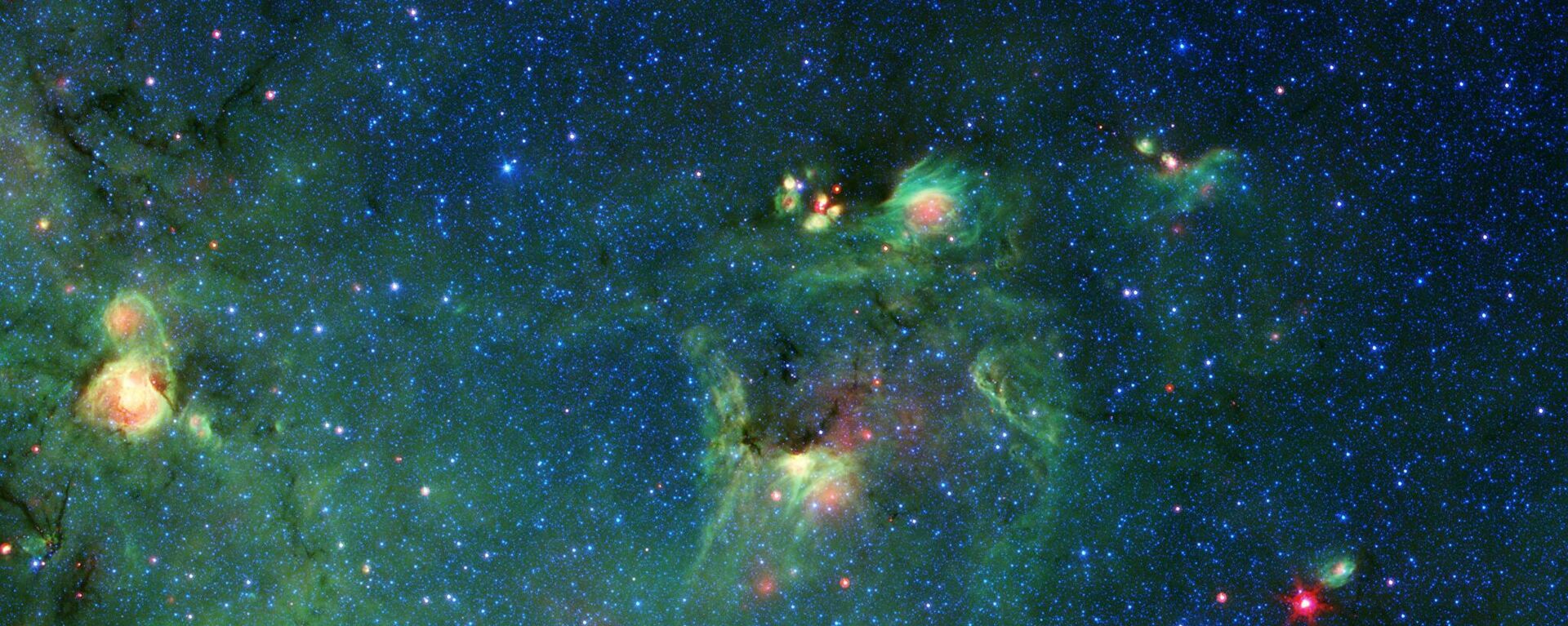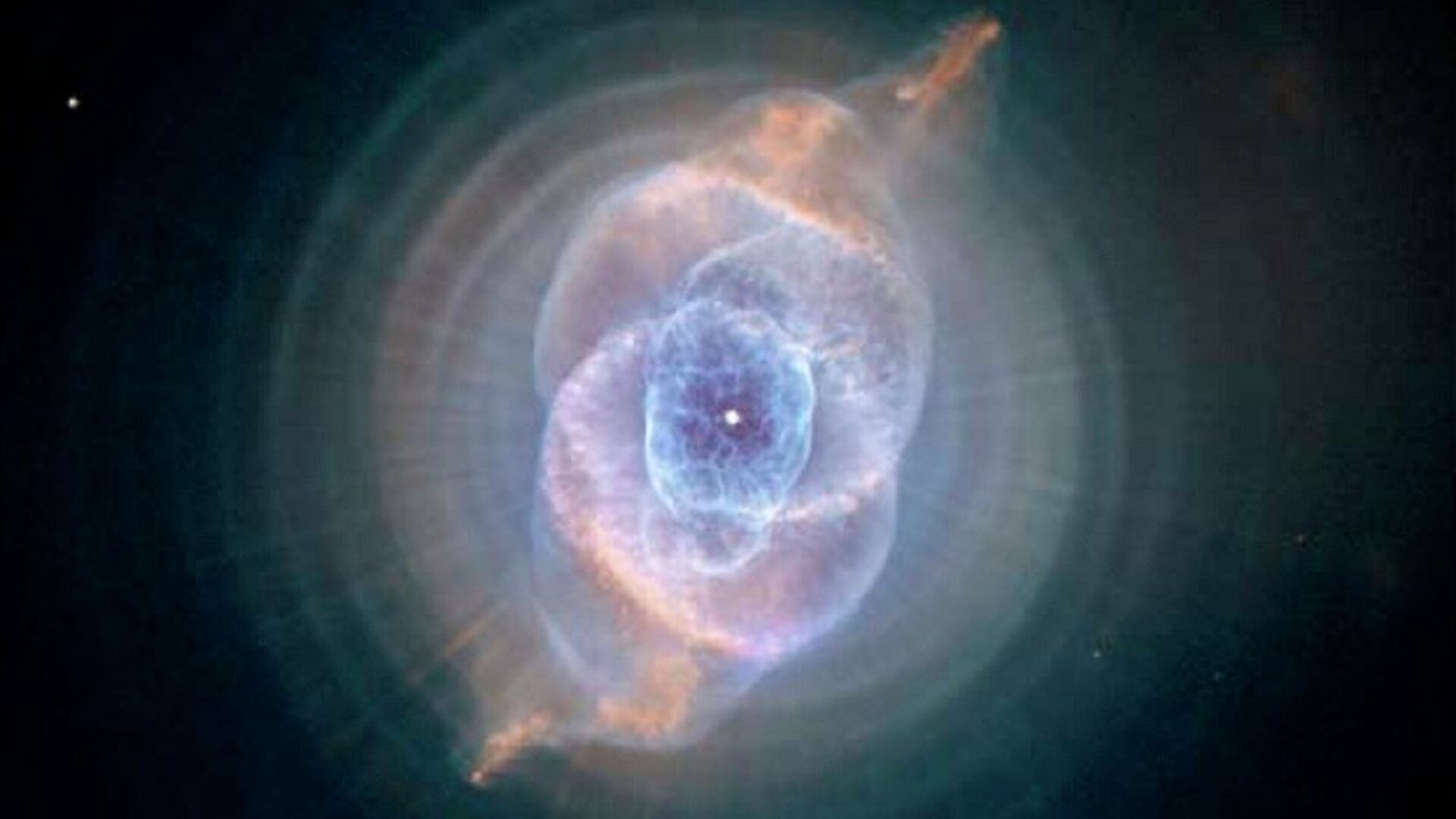https://sputnikglobe.com/20221008/new-3d-model-of-cats-eye-nebula-hints-at-its-binary-star-past-1101631602.html
New 3D Model of Cat's Eye Nebula Hints at Its 'Binary Star' Past
New 3D Model of Cat's Eye Nebula Hints at Its 'Binary Star' Past
Sputnik International
The Cat’s Eye Nebula, in the constellation Draco, was previously captured by the Hubble Space Telescope in high resolution. It was revealed to be an intricate... 08.10.2022, Sputnik International
2022-10-08T10:01+0000
2022-10-08T10:01+0000
2023-04-12T17:02+0000
science & tech
planetary nebula
nebula
hubble space telescope
space
https://cdn1.img.sputnikglobe.com/img/102134/49/1021344942_0:219:1001:782_1920x0_80_0_0_b5cb9713704ef45a7649539e918ceead.jpg
The first computer-generated three-dimensional model of the Cat's Eye Nebula, lying in the constellation Draco just over 3,000 light years away from Earth, has been created by researchers.Revealing a pair of symmetric rings encircling the nebula’s outer shell, the 3D model provides compelling evidence for a binary star once at the heart of the enormous cloud of dust and gas, according to the study led by Ryan Clairmont and published in Monthly Notices of the Royal Astronomical Society.A planetary nebula forms when a dying solar-mass star ejects its outer layer of gas. In doing so, the dying star produces a shell-like structure. However, the Cat’s Eye Nebula, also known as NGC 6543, boasting several overlapping bubbles of blue gas with long filaments, has mystified researchers. Images of the Cat’s Eye Nebula were previously captured by the Hubble Space Telescope in high resolution, revealing the structure with its spherical gas shells, jets of high-speed gas and unusual knots of gas.Astronomy enthusiast Ryan Clairmont, who recently completed secondary school in the US, decided that a detailed 3D structure of the Cat’s Eye would help determine the potential mechanism that gave it its intricate shape. Clairmont turned to Mexico- and Canada-based creators of a 3D astrophysical modeling software called SHAPE. Thus, together with Dr Wolfgang Steffen of the National Autonomous University of Mexico and Nico Koning from the University of Calgary, the team used spectral data collected from the San Pedro Martir National Astronomical Observatory in Mexico and images from the Hubble Space Telescope.The computer-generated map they created showed the movements of different layers of gas in the nebula. According to the researchers, there is only one possible explanation for the symmetrical rings eddying around the length of the nebula's outer shell - a burst of energy known as a precessing jet. This is a stream of high-density gas ejected in opposite directions from the nebula’s central star. According to the study, the symmetric rings were a signal that at the heart of the nebula was once a binary star system, with two central stars orbiting each other.
https://sputnikglobe.com/20211028/not-a-unicorn-take-a-look-at-nasas-newly-released-photo-of-nebula-that-resembles-godzilla-1090267076.html
Sputnik International
feedback@sputniknews.com
+74956456601
MIA „Rossiya Segodnya“
2022
News
en_EN
Sputnik International
feedback@sputniknews.com
+74956456601
MIA „Rossiya Segodnya“
Sputnik International
feedback@sputniknews.com
+74956456601
MIA „Rossiya Segodnya“
science & tech, planetary nebula, nebula, hubble space telescope, space
science & tech, planetary nebula, nebula, hubble space telescope, space
New 3D Model of Cat's Eye Nebula Hints at Its 'Binary Star' Past
10:01 GMT 08.10.2022 (Updated: 17:02 GMT 12.04.2023) The Cat’s Eye Nebula, in the constellation Draco, was previously captured by the Hubble Space Telescope in high resolution. It was revealed to be an intricate structure not explained by previously accepted theories for planetary nebula formation.
The first computer-generated three-dimensional model of the Cat's Eye Nebula, lying in the constellation Draco just over 3,000 light years away from Earth, has been created by researchers.
Revealing a pair of symmetric rings encircling the nebula’s outer shell, the 3D model provides compelling evidence for a binary star once at the heart of the enormous cloud of dust and gas, according to the study led by Ryan Clairmont and
published in Monthly Notices of the Royal Astronomical Society.A
planetary nebula forms when a dying solar-mass star ejects its outer layer of gas. In doing so, the dying star produces a shell-like structure. However, the Cat’s Eye Nebula, also known as NGC 6543, boasting several overlapping bubbles of blue gas with long filaments, has mystified researchers.
Images of the Cat’s Eye Nebula were previously captured by the Hubble Space Telescope in high resolution, revealing the structure with its spherical gas shells, jets of high-speed gas and unusual knots of gas.
Astronomy enthusiast Ryan Clairmont, who recently completed secondary school in the US, decided that a detailed 3D structure of the Cat’s Eye would help determine the potential mechanism that gave it its intricate shape. Clairmont turned to Mexico- and Canada-based creators of a 3D astrophysical modeling software called SHAPE. Thus, together with Dr Wolfgang Steffen of the National Autonomous University of Mexico and Nico Koning from the University of Calgary, the team used spectral data collected from the San Pedro Martir National Astronomical Observatory in Mexico and images from the
Hubble Space Telescope.
The computer-generated map they created showed the movements of different layers of gas in the nebula. According to the researchers, there is only one possible explanation for the symmetrical rings eddying around the length of the nebula's outer shell - a burst of energy known as a precessing jet. This is a stream of high-density gas ejected in opposite directions from the nebula’s central star. According to the study, the symmetric rings were a signal that at the heart of the nebula was once a binary star system, with two central stars orbiting each other.
“It was very rewarding to be able to do astrophysical research of my own that actually has an impact in the field. Precessing jets in planetary nebulae are relatively rare, so it’s important to understand how they contribute to the shaping of more complex systems like the Cat’s Eye. Ultimately, understanding how they form provides insight into the eventual fate of our Sun, which will itself one day become a planetary nebula,” Ryan Clairmont, the lead author of the paper and at present a prospective undergraduate at Stanford University, said in a statement.

28 October 2021, 03:42 GMT


